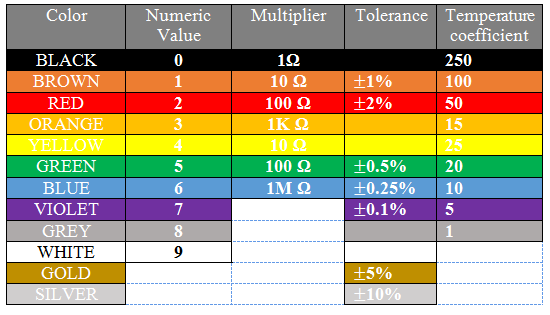A resistor color code calculator helps you quickly determine resistance values by selecting the appropriate color bands. This calculator is specifically designed for 4-band resistors, which are the most common type used in electronic circuits. Simply select the colors of each band in the calculator above to instantly get the resistance value and tolerance.
How to Calculate 4-Band Resistor Values?
Reading a 4-band resistor color code is straightforward when you understand the system. Each colored band represents a specific value. Like, the first two bands are significant digits, the third band is the multiplier, and the fourth band indicates tolerance. Use the resistor color code chart below to see how resistance values are calculated step by step.

Understanding 4-Band Resistor Color Codes
4-band resistors are the most widely used resistors in electronics, offering good precision for general applications. Unlike 5-band or 6-band resistors, they provide a simpler color coding system that's perfect for hobbyists and standard circuit designs. The 4-band system typically offers tolerances of ±5% or ±10%, making them ideal for non-critical applications.
When to use 4-band resistors: General purpose circuits, LED circuits, voltage dividers, pull-up/pull-down resistors, and educational projects. For high-precision applications requiring tighter tolerances, consider using 5-band resistor calculators instead.
Calculating Resistance for a 4-Band Resistor

![]()
Where,
'a' represents the 1st significant digit, which is the first band color of resistor.
'b' represents the 2nd significant digit, which is the second band color of resistor.
'c' represents the 3rd significant digit, which is the third band color of resistor and this is the multiplier value.
'd' represents the 4th significant digit, which is the fourth band color of resistor and this is the tolerance value.
| 4-Band | Name | Description |
| 1st Band | a | 1st significant digit |
| 2nd Band | b | 2ndsignificant digit |
| 3rd Band | c | Multiplier |
| 4th Band | d | Tolerance |
Step-by-Step 4-Band Resistor Calculation Example
Let's calculate a 4-band resistor with the colors: Brown, Black, Red, Gold
Step 1: First band (Brown) = 1
Step 2: Second band (Black) = 0
Step 3: Third band (Red) = ×100 (multiplier)
Step 4: Fourth band (Gold) = ±5% (tolerance)
Calculation: (1×10 + 0) × 100 = 10 × 100 = 1000 Ohms or 1kΩ with ±5% tolerance
This means the actual resistance value can range from 950Ω to 1050Ω (1000Ω ± 5%).
Common Applications for 4-Band Resistors
4-band resistors are essential components in countless electronic projects. Understanding where to use them helps you choose the right resistor type for your circuit design.
Electronics Projects Using 4-Band Resistors:
LED Circuits: Current limiting resistors for LEDs - use our LED resistor calculator to determine exact values.
Arduino Projects: Pull-up and pull-down resistors for digital inputs.
Voltage Regulation: Feedback networks in adjustable power supplies - check our LM317 calculator for voltage regulator designs.
Voltage Dividers: Creating reference voltages in analog circuits.
Audio Circuits: Biasing and filtering applications in amplifiers.
Power Supplies: Feedback networks and current sensing circuits.
Resistor Network Calculations:
When using multiple 4-band resistors together, you'll need additional calculations. Use our series resistor calculator or parallel resistor calculator to find total resistance values in complex circuits.
4-Band Resistor Calculator FAQ
What is the difference between 4-band and 5-band resistors?
4-band resistors have two significant digits and are typically used for general applications with ±5% or ±10% tolerance. 5-band resistors have three significant digits, offering higher precision with tighter tolerances like ±1% or ±2%. Use our 5-band resistor calculator for precision applications.
How do I read resistor colors if I'm colorblind?
Use a digital multimeter to measure resistance directly, or use smartphone apps that can identify resistor colors using your camera. You can also use our Ohm's law calculator to verify your measurements. Some resistors also have printed values instead of color codes.
What does the tolerance band tell me?
The tolerance band (usually gold or silver) indicates how much the actual resistance can vary from the calculated value. Gold = ±5%, Silver = ±10%. For precise power calculations, use our resistor wattage calculator alongside resistance calculations.
Can I use this calculator for surface mount resistors?
No, surface mount resistors use numerical codes instead of color bands. This calculator is specifically for through-hole resistors with color bands.
Update: This calculator was last updated in May 2025 to support the latest mobile devices and iPhone screens. If you are facing any problems in using the calculator or have any suggestions, kindly contact us.

